 One of the more novel presentations at the 2010 British Flute Society Convention in Manchester, England was the combined live concert and film presentation of music by Philippe Gaubert (1879-1941), performed by French flutist, Nicolas Duchamp and American pianist, Barbara McKenzie. Duchamp performed the concert on Gaubert’s flute, a Louis Lot No. 1986, which was built in 1874. Duchamp performed not only in a manner that one might consider characteristically French, but his interpretation of the flexible and transparent tone colors, combined with the inherent qualities of the flute itself, invoked a certain understanding of the period. I imagined I was as close as possible to listening to Gaubert himself.
One of the more novel presentations at the 2010 British Flute Society Convention in Manchester, England was the combined live concert and film presentation of music by Philippe Gaubert (1879-1941), performed by French flutist, Nicolas Duchamp and American pianist, Barbara McKenzie. Duchamp performed the concert on Gaubert’s flute, a Louis Lot No. 1986, which was built in 1874. Duchamp performed not only in a manner that one might consider characteristically French, but his interpretation of the flexible and transparent tone colors, combined with the inherent qualities of the flute itself, invoked a certain understanding of the period. I imagined I was as close as possible to listening to Gaubert himself.
After his presentation, Duchamp revealed the intricate set of circumstances that led to him being the official guardian of the Gaubert flute. Sharing Gaubert’s music and his instrument has turned into a personal odyssey for Duchamp who has embarked on a worldwide tour called Gaubert Vivant – Gaubert Lives. The U.S. tour to many major universities and conservatories began in October 2010 and continues into 2013.
Gaubert’s Flute
In 2003, a student approached Duchamp requesting lessons. She said that she had played the flute before and wanted to resume because there were flutists in her family. Three years later she entered Duchamp’s class holding an old flute case. It belonged to her mother-in-law, Yvette Poire-Gaubert. Mme. Poire-Gaubert had heard one of Duchamp’s recordings and wanted his advice on this particular old flute. It was Philippe Gaubert’s flute, the Louis Lot Nº 1986.
Yvette Poire-Gaubert, the only living heir of Philippe Gaubert, had another request – that Duchamp review the music of Philippe Gaubert that she had stored in her basement for over 60 years. “This was the gift of a lifetime. I couldn’t believe it. When I first saw the flute, it was in horrible condition. The case was completely broken. I went to a flute repair specialist and checked if it was real. We looked in the register and confirmed that it was legitimate.”
For three years, Duchamp held onto the flute in its tattered condition, and periodically tried to communicate with Yvette, who remained reclusive. His only recourse for communication with her was through his student, Aurelie. Over time Duchamp eventually earned Poire-Gaubert’s trust, and she gave her permission to proceed with repairing the flute.
Duchamp brought the flute to Philippe Roellandt in Paris for the major overhaul it needed, probably the first in nearly a century. “Everything had to be done on the instrument. He took everything off and just observed it for several days. He was prudent to do thorough research, so that he could repair it in a way authentic to the period, and not in the modern manner. He researched the pads and the glue that were used in the era and fabricated them himself. When he started, I was very impatient because I thought it would be like a normal overhaul! When I saw his work, however, I was very impressed.”
After the flute was repaired, Duchamp had his first meeting with Yvette in 2009. Yvette had been married to Gaubert’s step-son, Alain, who died in 2000. Gaubert told her that she could have his music when he died, but once she received it, she didn’t have a chance to go through it because she was busy with her husband’s movie business. “When her husband died, she started organizing Gaubert’s things and wrote a book, but didn’t want to publish it. I read it, and it’s fantastic. She tells some funny anecdotes about the family. It is a very personal work, and would need to have some work in order to be fit for publishing. She is now 92 years old.”
Gaubert left quantities of materials to his step-daughter-in-law, which she housed in her basement – photos, letters, and many original manuscripts, some unpublished, including a work in progress only a few bars long titled Boules de Neiges, which is dedicated to Yvette. Duchamp will be performing some of the unpublished works for the first time in his U.S. tour.
Also among the original manuscripts were those for the works that are known by most flutists: the Fantaisie, the Nocturne and Allegro Scherzando, and a lot of melodies for voice. “In my initial meeting with Yvette, she showed me Gaubert’s original Fantaisie – a piece I had studied since my youth. When I saw it, I noticed that there was a piece of paper on top of the cadenza with an alternative cadenza. The first published edition by Salabert had a cadenza, but Gaubert wanted it corrected. For the second edition he put a new paper on top. The first edition of 1914 no longer exists. What we play is his second edition cadenza. I think the second version is better, but I played the first cadenza in Weill Hall in Carnegie in January 2011.”
Of the correspondence Gaubert left to Yvette, there were letters from Paul Valery, Camille Saint-Saens, Georges Enesco, and Richard Strauss, among other famous personages. According to Duchamp, he now has enough to work on a new Gaubert biography.
Duchamp has encouraged Yvette and her family to organize and preserve the materials. “She explained that they have already done a lot of work in this regard. In fact, a long time ago she wanted to make a gift to the Paris Opéra. She brought them a box with the flute, his manuscripts, and his baton, but they said they didn’t care. They put the baton in the garbage! To them, Gaubert was a director like everyone else and therefore they weren’t interested.
“It’s a shame because now I think they will be interested. In the last 10 years they have changed and the Bibliothèque Nationale de France has a huge music department that does preservation. We will talk about this possibility with Mme. Poire-Gaubert.”
After overcoming her initial hesitation to become public with the historical treasures, Yvette has fully supported both recorded and live performances, including the current U.S. tour. Starting in 2010, a renaissance of Gaubert’s orchestral works began, with the recording of Gaubert’s ballet, Le Chevalier et La Damoiselle (Timpani) by Orchestre Philharmonique du Luxembourg, under conductor Marc Soustrot.
Duchamp’s project, “Gaubert Vivant” is a large part of this Gaubert revival. He and his pianist McKenzie will not only tour but also record live performances on the Gaubert flute. “In October 2009, we organized our first free concerts in Paris based on the works of Gaubert and his friends. We performed in conjunction with an exhibition of all the documents associated with the Gaubert flute. Yvette spoke at the event, especially about Gaubert’s Souvenir.
Duchamp had begun thinking about a Gaubert project shortly after meeting Yvette. At the invitation of the French music production company, Cap Musique France, Duchamp began production on a documentary film using the artifacts and manuscripts in Yvette’s holdings. His idea was to pair the film with a live performance of not only Gaubert’s works, but also those of Taffanel. “Gaubert Vivant” (“Gaubert Alive”) was born.
The film started production in October 2009 and was finished in June 2010. The main difficulties arose in sifting through mountains of materials to compile the components, and in refurbishing the photos and other documents. Yvette helped to fund the project, and there were a lot of passionate volunteers as well.
The result was an overwhelming success at the British Flute Society Convention, and is now in the U.S. for over a year’s worth of performances at universities and concert halls throughout the country. The performances will offer a 55-minute film, including interviews with Yvette Poire-Gaubert, interspersed with the silken sounds of the original Gaubert flute performing not only Gaubert classics but never-before-heard gems resurrected from the Gaubert archives. Also included on the program will be the Scherzando performed from the original manuscript, showing Gaubert’s corrections to the score.
Having the Gaubert flute quite literally fall into his hands was life-changing for Duchamp and his discoveries and efforts will affect generations of flutists and audiences. According to Duchamp, “More and more I feel the spirit of Gaubert.”
Philippe Gaubert
“Jules Taffanel, the father of Paul Taffanel, discovered Philippe Gaubert. After giving Gaubert a free lesson he sent him on to his son, Paul. Through Taffanel, Gaubert entered the Conservatoire de Paris and eventually took over for Taffanel as the professor of flute. Gaubert also received Taffanel’s baton, taking over his positions conducting the Paris Opéra and the Société des Concerts du Conservatoire. Gaubert began conducting without classes and was a highly gifted conductor and composer. He studied counterpoint and fugue at the Conservatoire de Paris.”
Nº 1986 Louis Lot Flute
According to Duchamp, Gaubert bought the Nº 1986 Louis Lot flute when he was around 17 or 18 years old, in approximately 1886. It was manufactured in 1874, but Duchamp is uncertain from whom Gaubert purchased it. “I thought it was from Paul Taffanel, but it wasn’t. I think Taffanel also played a Louis Lot. Gaubert had this instrument when he started to play at the Paris Opéra. It is a late production Louis Lot. The Louis Lot flute was ideal for playing impressionistic/transparent music. The way to compose and build instruments went hand in hand. At the beginning the Lots weren’t always Boehm models.”
Between 1855 and 1876, approximately 2,700 flutes were manufactured with the mark, “L.L./Louis Lot/Paris.” According to Tula Giannini, about 900 of these were metal, usually silver, around 1800 were Boehm-system wooden flutes and piccolos, and a few were simple system flutes. Lot had collaborated with Louis Dorus on the development of the metal, French-model, cylinder Boehm flute.1 In 1860, Louis Lot became the official supplier to the Conserva-toire de Paris. When Lot retired in 1876, H.D. Villette headed the company until 1882 and was the first in a long line of successors. The Louis Lot mark was by then considered by many to be the highest quality flute ever made. Even Boehm himself was in awe of the brand, ordering 20 keyless flutes between 1855 and 1863. (T. Giannini, 2010)
According to Duchamp’s research, Gaubert stopped playing officially when he was 40, around 1919. Duchamp theorizes that it was mainly due to Gaubert’s busy schedule composing and conducting. “He worked all night, and during the day he taught at the Conservatoire de Paris 3 days a week. The days he didn’t teach, Marcel Moyse taught since he was Gaubert’s assistant. Gaubert was conducting what is now the Orchestra d’Paris as well as the Paris Opéra.
“The official reason he quit flute playing, however, is that he had a lip problem. According to his biography, Gaubert served in WWI. He was very patriotic. He loved France and wanted to defend it even though at 38 he was pretty old to be in the military. In 1917 he was kicked out of the French army because of a lung problem.
“After a bad first marriage, he married Madeleine Poire, who was from a very wealthy and artistic family. She was divorced with two children from a previous marriage. Her son, Alain Poire, was the founder of a big movie company in France, producing 244 successful movies.”
Nicolas Duchamp
French flutist Nicolas Duchamp was born in Bordeaux in 1968 and is the product of the French school of flute playing. He studied four years with his first teacher, Stephane Boudot, principal flute in the Bordeaux Opera Orchestra. After graduating from the Bordeaux Conservatoire he continued his studies with Maurice Pruvot, principal piccolo with the Orchestre de Paris at the national school of Creteil, a conservatory close to Paris. He also studied with Georges Alirol and Maxence Larrieu at the Conservatoire National Superieur de Musique de Lyon as well as Catherine Cantin, Jean-Pierre Rampal, and Michel Debost.
Since 2004, Duchamp has served as principal flute in the French National Opéra Comique and has performed as soloist with the Paris Opera Bastille, the Nice Opéra, the Strasbourg National Opéra and the Bordeaux National Opera. In 2003 he received recognition from the French Senate and has won prizes in various competitions.
Duchamp’s grandmother, an opera singer, first introduced him to music. The flute was his first and immediate infatuation. “I wanted to be a flutist since I was three years old. I waited a long time before I started at 11. At that time, teachers didn’t think students should start as early as they do now. I was really craving the flute and pretended to play on sticks or anything I could find. Once I was finally allowed to play, I progressed very rapidly. I think this was because being denied the opportunity to play flute when I wanted to, gave me a lot of energy once I started.
“When I was 14, I won a first prize in a competition in Bordeaux. Afterward my teacher, Stephane Boudot, told me that I should continue with someone very serious, perhaps even with Rampal in Paris. With this suggestion, I went for a few lessons with Rampal.
“Rampal didn’t give me too many specific instructions, but he was very energetic. He simply said, ‘Do this and this…’ and then I found that I could do it. His approach wasn’t intellectual – it was magical. He told me I had to prepare for the entrance competition for the Conservatoire. I needed to seriously strengthen my skills and improve my playing quality in order to enter the flute class where I would be exposed to a higher level of playing.”
Early Influence of Gaubert
After two years working with Maurice Pruvot, Duchamp finished his “superior studies” at the national school of music of Creteil in 1985. Pruvot’s father, who was also named Maurice Pruvot, was a flutist, and had been a student of Gaubert. “He told me a lot about how Gaubert was as a teacher. I practiced a lot and played the Gaubert Fantasie, the Dutilleux Sonatine, and all the French repertoire. It was not only the fashion but obligatory to play this repertoire if you wanted to get into the Conservatoire Superior de Paris or Lyon. The particular demands of this music gives you a profound understanding of the approach needed to perform it, such as exploring the various colors, articulations, vibrato parameters, rhythms, and musical structures. As it turns out, Philippe Gaubert had already entered my life because my musical education was in the tradition of his teaching and music.”
For more information on the tour, including concerts and masterclasses in the French style, consult the following: http://gaubertvivant.musicblog.fr, http://duchamp.musicblog.fr. Nicolas Duchamp can be contacted at duchampus@gmail.com.
References
1Tula Giannini. “Lot.” In Grove Music Online. Oxford Music Online, http://www.oxfordmusiconline.com/subscriber/article/grove/music/17016pg4 (accessed October 22, 2010).






